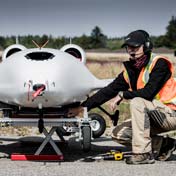High-tech bandage uses phone app to identify infection
- Jody Paterson

A “smart bandage” that detects and treats infection using a smartphone app has the potential for transformative advances in wound care, says UVic bioengineer Mohsen Akbari, principal investigator of a study published this week which describes the science behind the innovation.
Akbari and his UVic-based research team with collaborators from Harvard Medical School and UBC are working with UVic Industry Partnerships to commercialize GelDerm, a patent-pending bandage that monitors pH levels at wound sites to detect the earliest signs of bacterial infection.
A patient using GelDerm will be able to scan over the bandage’s embedded sensors with a smartphone app to gauge whether infection has set in. The information can be used for self-monitoring and can be relayed wirelessly to a patient’s health care team for follow-up.
Should antibiotics be required to treat an incipient infection, they can be administered directly through the bandage without having to remove it.
“There’s a pressing need to develop advanced dressings that can monitor wound conditions and provide proper treatment when necessary,” says Akbari, whose bandage was featured on the cover of Advanced Health Care Materials on Sept. 25. “The proposed technology holds great promise in managing chronic and acute injuries caused by trauma, surgery or diabetes.”
Skin is the largest organ in the body, and an important barrier against bacteria and other pathogens. Gel- Derm’s proven ability to spot infection through changes in pH levels and localize antibiotic treatment at the wound site means potentially lifethreatening infection is identified and treated quickly.
While electronics-based approaches to wound care are already being developed by several researchers around the world, Akbari says GelDerm is the first that functions without a power source and whose readings aren’t compromised by the multitude of substances that leak from a wound.
Akbari anticipates the bandage could be on the market within five years once industry partners have been identified.
Wound management is a major health challenge around the world that racks up significant public expenditures. A 2016 report from the World Health Organization found that in the US alone, infections at surgical incision sites result in more than 400,000 extra days in hospital for patients each year, at a cost of almost $1 billion US.
“This all-in-one bandage that detects infection and administers treatment without having to be removed will reduce costs and save lives,” says Akbari.
GelDerm’s ability to administer antibiotics directly at the wound site rather than through a general course of medication also reduces problems of antibiotic overuse, such as the growth in drug-resistant “superbugs” that now kill 10 million people annually.
The research was funded by the Canadian Institutes for Health Research and the Canada Foundation for Innovation.
Learn more about research at UVic.
Photos
In this story
Keywords: engineering, mechanical engineering, biomedical, health, technology, research
People: Mohsen Akbari, Aziz Ghahary, Yu Shrike Zhang, Bahram Mirani







